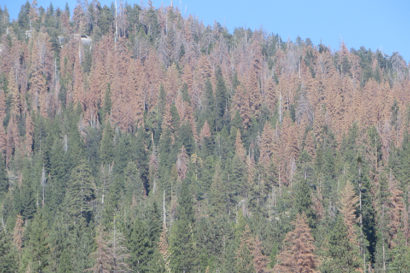100 million dead trees in the Sierra are a massive risk for unpredictable wildfires
To drive through parts of the Sierra Nevada these days is to witness a morbid reminder of California’s extreme drought: Vast landscapes of standing dead trees, a brown tide sweeping across the green landscape. It’s more than eerie; it’s a dangerously combustible situation, argues a new publication from Berkeley fire scientists.

The problem is so severe in the central and southern Sierra Nevada that some areas have experienced greater than 90 percent tree mortality. The study authors caution that these dead trees have created unprecedented levels of fuel, which could create dangerous wildfires in the near future that are beyond the predictive capacity of current fire models, making fire behavior and its impact on structures and public safety difficult to manage and predict.
Forest managers have already been struggling to determine whether the massive number of dead trees will increase wildfire intensity and/or severity, what the near- and long-term effects on forest communities will be and how land management agencies should respond. The new study argues for more prescribed fires, mechanically thinning forests and physically removing dead trees to combat the near-term fire threat. For long-term adaptation to climate change, the study highlights the importance of moving beyond triage of dead and dying trees to making live forests more resilient.
“If our society doesn’t like the outcomes from recent fires and extensive drought-induced tree mortality in Sierra forests, then we collectively need to move beyond the status quo,” said study co-author Scott Stephens, professor of fire science at Berkeley. “Working to increase the pace and scale of beneficial fire and mechanical treatments rather than focusing on continued fire suppression would be an important step forward.”
The study was published January 17 in the journal BioScience.
Most western U.S. ecosystems like the Sierra Nevada are fire dependent, meaning that for millennia, the flora and fauna depended upon periodic low- to moderate-intensity fires to maintain ecosystem integrity. Following Euro-American settlement, aggressive fire suppression in the early 1900s created denser forests. These denser forests, in turn, have created greater competition among trees for water and other resources, making them prone to mortality from things like bark beetles during multi-year droughts, which is what happened in the Sierra. According to recent estimates, more than 100 million trees have died in California primarily in the southern and central Sierra Nevada, prompting the governor to declare a state of emergency.
In many wildfires burning today in forests that historically had frequent fires, tree mortality patches are an order of magnitude or two larger than those that occurred in the past. The study points to many other implications from the recent tree mortality for the future of these forests and the ecological goods and services they provide to society.
Future wildfire hazard following this mortality can be generally characterized by increased surface fire intensity in the short- to intermediate-term. That’s because many of the trees killed by bark beetles are the largest trees and not the trees that would be preferentially killed by low-moderate-severity wildfires or targeted for removal in restoration projects. Also, bark beetle-killed trees are often not removed, as is commonly the case in restoration projects involving mechanical thinning or in forests subject to centuries of frequent fires. So tree biomass remains on site as potential fuel for fires.
Dense forests of dead trees increase the amount and continuity of dry, combustible, large, woody material. Unless some of this dead biomass is removed, either mechanically or by fire, recent and current bark beetle-caused tree mortality in the Sierra Nevada could add 10s to 100s of megagrams per hectare of dry woody fuel to the wildland fuel complex.
The massive amounts of large-sized woody fuels in future decades may contribute to dangerous fires beyond the predictive capacity of current fire models. These fires can generate their own wind and weather conditions and create fire-producing sparks or embers that are carried by the wind and which start new fires, making fire behavior and its impact on structures and public safety difficult to manage and predict. In addition, such intense fires could prevent forests from becoming re-established.
“Tree mortality at the levels we’ve observed in the central and southern Sierra Nevada sets the stage for potential fire activity that is well beyond what we can predict with our current operational fire-behavior models,” said Brandon Collins, a research scientist at the Berkeley Center for Fire Research and Outreach, and a co-author of the study. “This heightened fire potential is even more daunting when you consider how much total area has already experienced high levels of tree mortality.”
